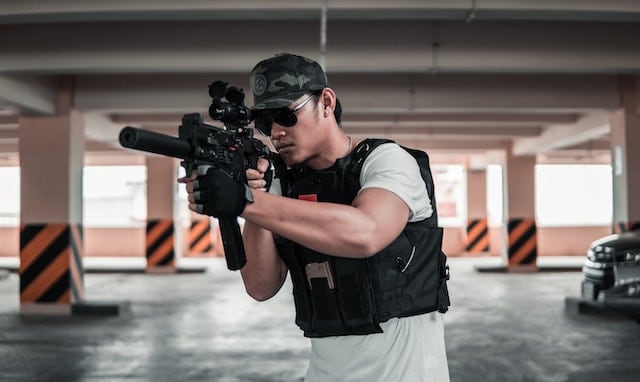Overview of Tactical Vests
Tactical vests are essential tools used by various professional forces such as police, military, SWAT teams, and Navy Seals. They are designed to offer protection, flexibility, and storage for essential items needed in the field. In this comprehensive guide, we will explore the various types of tactical vests and provide an exhaustive step-by-step guide on how to set them up.
Police Vest
The police tactical vest is generally lighter, offering Level IIIA protection. Its design allows for more flexibility, making it suitable for everyday law enforcement activities. It’s typically equipped to withstand stab attacks.
Military Vest
Heavier than the police vest, the military tactical vest offers Level III protection. It’s tailored to withstand bullet impacts and is typically used by military personnel who may be exposed to armed threats.
SWAT Vest
These vests are designed for special units, providing Level IV body armor protection. They are bullet-resistant and used by SWAT teams in high-risk situations.
Navy Seal Tactical Vest
The Navy Seal Tactical Vest is customized according to the mission, environment, and the wearer’s role within the platoon. It generally offers Level IV protection and is designed for optimal performance in diverse conditions.
Tips for Setting Up a Tactical Vest
The process of setting up a tactical vest is meticulous and requires careful consideration of the individual’s specific needs, mission requirements, and comfort. Here are some general tips:
- Understand Your Requirements: Identify the specific needs of your role, be it law enforcement, military, or other specialized roles.
- Select the Right Body Armour: Decide between tactical vests or plate carriers based on protection requirements.
- Choose Relevant Accessories: Customize accessories according to daily responsibilities and mission specifics.
Step 1: Choose Your Body Armour
The body armor acts as the outer shell of the tactical gear setup. Understanding the required protection level helps you decide whether a tactical vest or plate carrier would be better suited.
- Tactical Vest: Generally lighter and less bullet-resistant.
- Plate Carrier: Heavier but provides superior protection.
Step 2: Choose Your Accessories
Vest accessories must align with the nature of use and can vary widely:
- Pouches: For storing essential small items.
- Holsters: To securely hold firearms.
- Flashlights: Essential for low-light scenarios.
- Carabiners: Useful for attaching gear.
- Gun/Weapon Retention: Ensures secure weapon storage.
Step 3: Arrange the Accessories Around the Armour
The proper arrangement of accessories plays a crucial role in functionality:
- Balance: Ensure that the weight is equally distributed.
- Accessibility: Place frequently-used items within easy reach.
- Mobility: Keep the front of the vest as flat as possible for better movement.
Step 4: Put on the Tactical Vest
The final step involves putting on the vest and making necessary adjustments for comfort. Regular trials are vital to maintain familiarity with the arrangement.
Essential Items for Your Tactical Vest
Mission-specific deployment may require the inclusion of certain essential items:
- Ammo Kit or Pouch: Contains a holster for weapons and extra magazines.
- First Aid Kit: Vital for emergency medical care.
- Hydration Pack: Holds more water than typical bottles.
- Communication Kit: Ensures robust communication within the team.
For Law Enforcement
Law enforcement personnel may require accessories like extra handcuffs, keys, radios, tasers, pepper sprays, batons, etc. Quick access to these items is critical.
For Military Personnel
Military personnel may have different essential items like navigation tools, advanced communication devices, specialized ammunition, etc.
FAQs
What’s the Purpose of a Tactical Vest?
Tactical vests serve dual purposes of utility and protection. They offer bullet-resistant coverage and assist in carrying essential items during deployment.
What Should Be on Your Tactical Vest?
The composition varies based on individual needs and mission requirements. Customizable accessories, combined with essential must-haves, define the vest’s functionality.
Is a Tactical Vest a Bulletproof Vest?
Though similar in purpose, tactical vests and bulletproof vests are not interchangeable. Tactical vests are specialized bulletproof vests used mainly by professionals in the field.
Conclusion
Setting up a tactical vest involves more than mere assembly. It’s a careful orchestration of understanding needs, selecting appropriate body armor and accessories, meticulous arrangement, and continual practice to ensure comfort and utility. From the streets of urban law enforcement to the challenging terrains of military deployment, tactical vests play a crucial role in safety and effectiveness. By adhering to this guide, one can ensure that a tactical vest is set up to cater precisely to individual requirements, whether protection, utility, or both. In a world where precision can be the difference between success and failure, understanding how to optimally set up a tactical vest is not just a skill; it’s a necessity.
